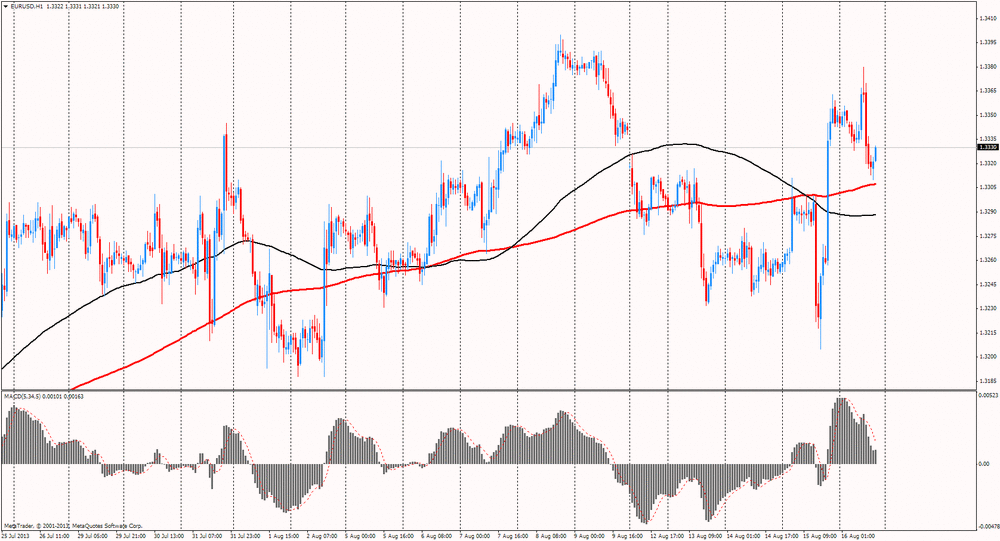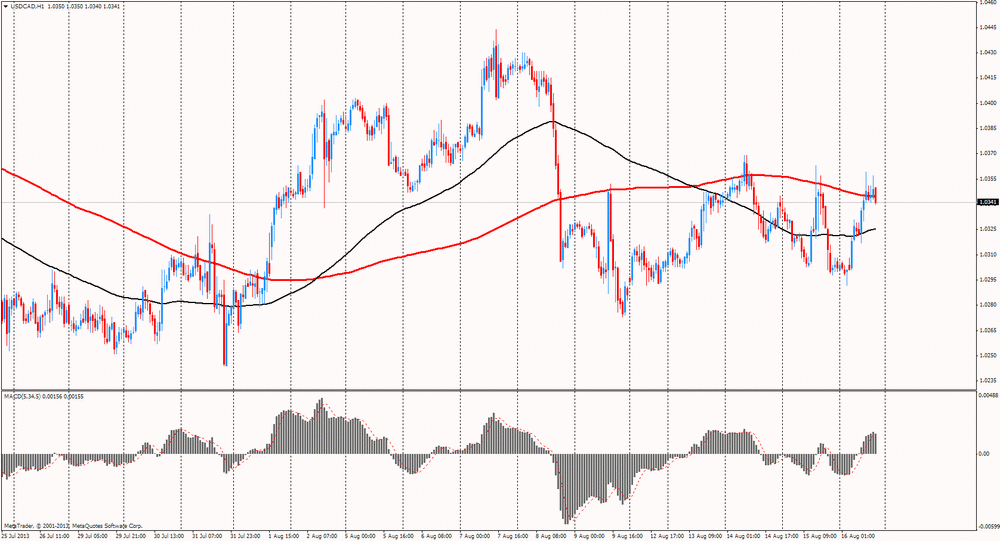Notícias do Mercado
-
19:20
American focus: the dollar rose sharply against most currencies
The dollar rose sharply against the euro, while restoring all previously lost ground, despite the lack of drivers for this move. Note that initially the pressure on the dollar was weak data on the number of Housing Starts. As it became known, the total number of housing starts in the U.S. rose by 5.9% in July compared with the previous month to a seasonally adjusted annual rate of 896,000 units. Construction of multi-family housing, including apartments, rose 26%, while single-family housing declined Share 2.2%. Compared with a year earlier, the whole establishment of new homes rose by 20.9%. Economists forecast that overall housing starts will rise by 8.9%.
Add that are not pleased as the data and consumer confidence. The preliminary results of the studies that were presented Thomson-Reuters and the Michigan Institute in August, U.S. consumers are feeling more pessimistic about the economy than had been recorded in the last month. According to a report in the August consumer sentiment index fell to 80.0, compared with a final reading for July at 85.1. It is worth noting that according to the average estimates of experts, the index should have grown to the level of 85.6.
However, even this did not prevent the negative dollar rise sharply. We add that the central theme for the dollar remains the impact of news on the likelihood of reducing the redemption of bonds by the Fed. Today's news, rather, added questions about whether the Fed reason for this step, as the index of consumer confidence in the U.S. declined significantly in August compared with July.
The cost of the Canadian dollar fell against the U.S. dollar, which was due to the expectation of the release of data for Canada, which had a worse than expected.
Statistics Canada reported Friday that shipments in the manufacturing sector fell unexpectedly in June, showing the fourth drop in six months, due to lower sales of jewelry and silver, metal, and wood products.
Deliveries in the manufacturing sector decreased by 0.5% to 48,220 million Canadian dollars ($ 46.8 billion), after a revised down 0.6% gain in May. Economists had expected delivery in the manufacturing sector of the industry will grow by 0.5% after rising 0.7% the previous month, which was originally reported.
Also, the report showed that inventories in the manufacturing sector in June fell by 0.2% compared with May, and unfilled orders in the manufacturing sector grew in June by 2.7% compared to the previous month.
New orders in the manufacturing sector in June rose by 2.5% compared with May. The ratio of reserves / supply to the industrial sector in Canada in June of 1.42:1.
-
14:55
U.S.: Reuters/Michigan Consumer Sentiment Index, August 80.0 (forecast 85.6)
-
14:45
Option expiries for today's 1400GMT cut
EUR/USD $1.3200, $1.3250, $1.3270, $1.3300, $1.3350, $1.3395, $1.3400
USD/JPY Y97.00, Y97.10, Y97.50, Y98.10, Y99.00, Y98.00, Y98.90
EUR/JPY Y130.00
GBP/USD $1.5400, $1.5500, $1.5650, $1.5675
EUR/GBP stg0.8550
GBP/JPY Y151.25
USD/CHF Chf0.9360
EUR/CHF Chf1.2420, Chf1.2430, Chf1.2550
AUD/USD $0.9100, $0.9105, $0.9150, $0.9160/65, $0.9200
USD/CAD C$1.0375, C$1.0410
-
13:31
Canada: Foreign Securities Purchases, June -15.41 (forecast 7.77)
-
13:31
Canada: Manufacturing Shipments (MoM), June -0.5% (forecast +0.5%)
-
13:31
U.S.: Nonfarm Productivity, q/q, Quarter II +0.9% (forecast +0.5%)
-
13:30
U.S.: Housing Starts, mln, July 0.896 (forecast 0.905)
-
13:30
U.S.: Building Permits, mln, July 0.943 (forecast 0.945)
-
11:01
Eurozone July inflation steadies as estimated
Eurozone's annual inflation stayed unchanged in July as estimated earlier, final data released by the Eurostat showed Friday.
The harmonized index of consumer prices (HICP) increased 1.6 percent on an annual basis in July, which was unchanged from the growth recorded in June. The outcome also matched the preliminary estimates.
Inflation was influenced by a 1.6 percent gain in energy prices, and a 3.5 percent increase in prices of food, alcohol an tobacco. Costs of non-energy industrial goods were higher by 0.4 percent than in July 2012.
Core inflation, excluding food, alcohol and tobacco, was 1.1 percent in July, down from the previous month's 1.2 percent. The latest figure matched flash estimates.
The lowest annual rates were observed in Greece, Bulgaria and Denmark (0.4%), and the highest in Estonia, Romania and the Netherlands.
On a monthly basis, the HICP recorded a 0.5 percent decrease in July, the agency said.
In the European Union (EU), the annual inflation rate was 1.7 percent in July, unchanged from the previous month. Month-on-month, consumer prices dropped 0.4 percent in the EU.
-
10:24
Option expiries for today's 1400GMT cut
EUR/USD $1.3200, $1.3250, $1.3270, $1.3300, $1.3395, $1.3400
USD/JPY Y97.00, Y97.10, Y97.50, Y98.10, Y99.00, Y98.00, Y98.90
EUR/JPY Y130.00
GBP/USD $1.5400, $1.5500
EUR/GBP stg0.8550
GBP/JPY Y151.25
USD/CHF Chf0.9360
EUR/CHF Chf1.2420, Chf1.2430, Chf1.2550
AUD/USD $0.9100, $0.9105, $0.9150, $0.9160/65, $0.9200
USD/CAD C$1.0375, C$1.0410
-
10:02
Eurozone: Trade Balance s.a., June 14.9 (forecast 15.3)
-
10:00
Eurozone: Harmonized CPI ex EFAT, Y/Y, July +1.1% (forecast +1.1%)
-
10:00
Eurozone: Harmonized CPI, Y/Y, July +1.6% (forecast +1.6%)
-
10:00
Eurozone: Harmonized CPI, July -0.5% (forecast -0.5%)
-
09:00
Eurozone: Current account, adjusted, bln , June 16.9 (forecast 21.2)
-
07:02
Asian session: The dollar is poised for its biggest weekly gain
1:30 Australia RBA Assist Gov Debelle Speaks
The dollar is poised for its biggest weekly gain in a month versus the yen with benchmark Treasury yields at a two-year high before data that may add to signs of an improvement in the U.S. economy.
The U.S. currency is set for a weekly advance against most major peers before reports forecast to show housing starts rebounded and consumer confidence increased to a six-year high. A report from the Commerce Department due today is forecast in a Bloomberg News survey to show housing starts climbed in July to a 900,000 annualized rate from an 836,000 pace in June. In a sign construction will keep advancing, building permits are projected to increase to a 945,000 rate from 918,000 the prior month.
The Thomson Reuters/University of Michigan index of consumer sentiment probably advanced to 85.2 in August from 85.1 in July, according to the median projection of economists surveyed by Bloomberg.
The Federal Reserve will reduce bond purchases next month according to economists in a Bloomberg survey. Fed Chairman Ben S. Bernanke will probably reduce the central bank’s monthly bond purchases next month, 65 percent of economists surveyed by Bloomberg predict. The Federal Open Market Committee’s first step may be small, with monthly purchases tapered by $10 billion to a $75 billion pace, according to the median estimate in the survey of 48 economists conducted Aug. 9-13.
New Zealand’s dollar advanced to the strongest level since June as the nation’s two-year swap rate rose to its highest level since August 2011.
EUR / USD: during the Asian session the pair fell to $ 1.3335
GBP / USD: during the Asian session the pair traded in a range of $ 1.5625-45
USD / JPY: during the Asian session the pair rose to Y97.65
A fairly light data calendar today, the US providing the main points of interest with housing data at 1230GMT and UofM at 1355GMT.
-
06:20
Currencies. Daily history for Aug 15'2013:
(pare/closed(00:00 GMT +02:00)/change, %)
EUR/USD $1,3350 +0,70%
GBP/USD $1,5644 +0,89%
USD/CHF Chf0,9258 -0,99%
USD/JPY Y97,26 -0,76%
EUR/JPY Y129,84 -0,08%
GBP/JPY Y152,13 +0,13%
AUD/USD $0,9138 +0,15%
NZD/USD $0,8072 +0,52%
USD/CAD C$1,0302 -0,36%
-
06:01
Schedule for today, Friday, Aug 16’2013:
01:30 Australia RBA Assist Gov Debelle Speaks
08:00 Eurozone Current account, adjusted, bln June 19.6 21.2
09:00 Eurozone Trade Balance s.a. June 14.6 15.3
09:00 Eurozone Harmonized CPI July +0.1% -0.5%
09:00 Eurozone Harmonized CPI, Y/Y (Finally) July +1.6% +1.6%
09:00 Eurozone Harmonized CPI ex EFAT, Y/Y July +1.2% +1.1%
12:30 Canada Manufacturing Shipments (MoM) June +0.7% +0.5%
12:30 Canada Foreign Securities Purchases June 6.74 7.77
12:30 U.S. Building Permits, mln July 0.911 0.945
12:30 U.S. Housing Starts, mln July 0.836 0.905
12:30 U.S. Nonfarm Productivity, q/q (Preliminary) Quarter II +0.5% +0.5%
13:55 U.S. Reuters/Michigan Consumer Sentiment Index (Preliminary) August 85.1 85.6
-

